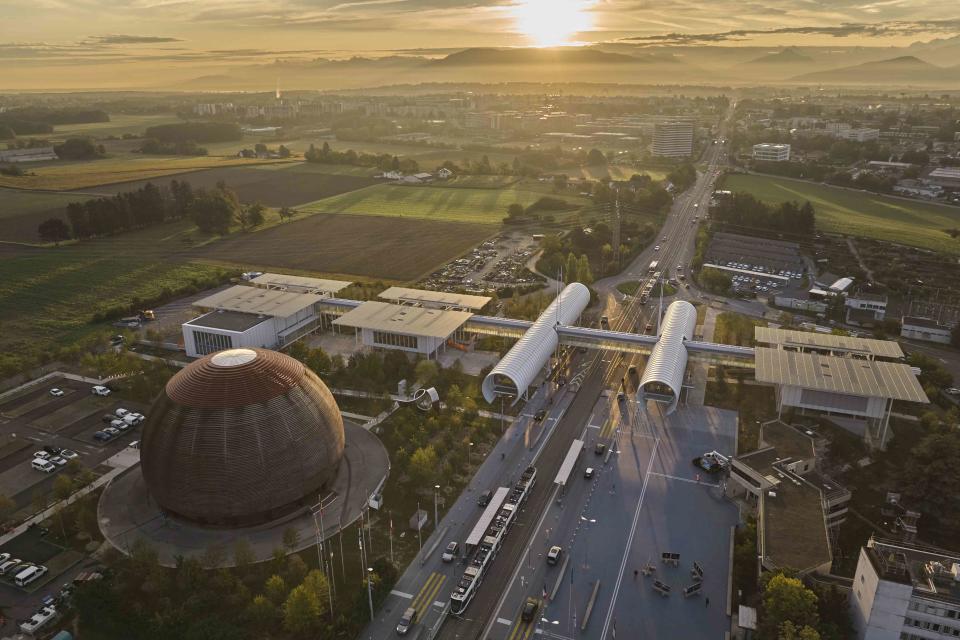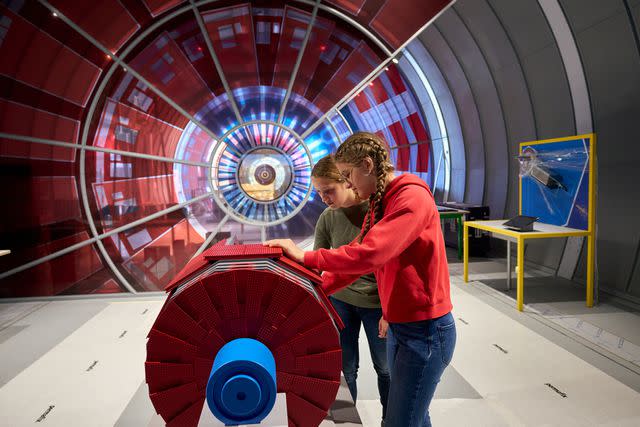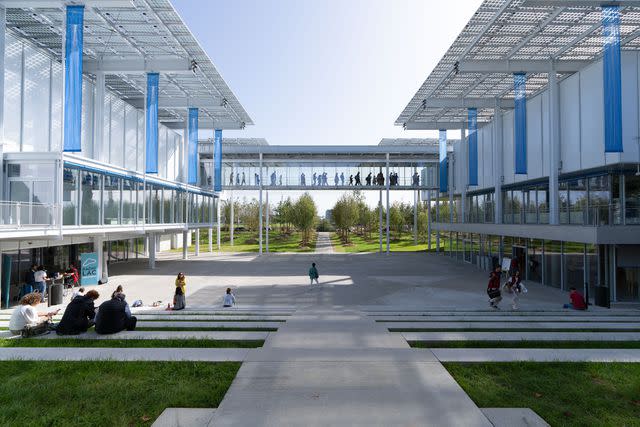This New Swiss Museum Is the Perfect Way to Get Your Kids Excited About Science — Here's How to Visit and What to See
Particle physics is having a moment (ever heard of a little film called "Oppenheimer"?) Get to know the secrets of the universe at this newly opened Swiss museum.

Courtesy of CERN Science Gateway
Part of the CERN Science Gateway, in Geneva, is suspended over the main road leading into the city.On July 4, 2012, scientists at the world’s largest and most powerful particle accelerator, located 328 feet below the France-Switzerland border outside Geneva, announced that the existence of the Higgs boson — a wave theory first proposed in 1964 — had been proven. It made global headlines, offering new insight into the formation of the universe, and the researchers went on to win the Nobel Prize.
The complex where the discovery happened — the home of the European Organization for Nuclear Research, or CERN — has been mostly closed to the public since it opened 70 years ago. In October, in an effort to bring quantum physics to the masses, the CERN Science Gateway opened. The interactive museum invites visitors as young as five.
Related: 20 Best Places to Visit in Switzerland
The $111 million building, designed by star architect Renzo Piano, mimics the look of particle accelerators. Two tubes — which appear to be suspended in midair — are connected by a bridge, evoking the themes of atomic movements and information exchange. The structure is also solar-powered and carbon-neutral.

Courtesy of CERN Science Gateway
Young visitors explore the “Discover CERN: Collide” exhibition at the Gateway.The $111 million building, designed by star architect Renzo Piano, mimics the look of particle accelerators. Two tubes — which appear to be suspended in midair — are connected by a bridge, evoking the themes of atomic movements and information exchange. The structure is also solar-powered and carbon-neutral.
"CERN was established in 1954 by a group of visionaries (including the famous Danish physicist Niels Bohr) who wanted to create a world-class laboratory for nuclear research in Europe."
Inside are three exhibitions, two labs, and a 900-seat auditorium. Kids (and adults) can travel back 13.8 billion years to the big bang with computer simulations, or play “quantum tennis” by using their voices — the sound of the speech is projected as a tiny particle that bounces back and forth. CERN scientists also teach short classes on topics including cloud formation, thermodynamics, and how electrons behave in magnetic fields.
The LEGO Robotic Challenge is another fun, hands-on experience. During real-life experiments at CERN, robots are often used in places where humans could be injured. To understand how these safety dilemmas are solved, children assemble a small robot, attach a sensor, and help an engineer program it to perform certain tasks.

Maximilien Brice/Courtesy of CERN Science Gateway
Guests at CERN Science GatewayVisitors can also learn about CERN’s history. The center was established in 1954 by a group of visionaries (including the famous Danish physicist Niels Bohr) who wanted to create a world-class laboratory for nuclear research in Europe. It was a reaction to the brain drain after World War II, when many European scientists moved to America. Twelve nations were the original signatories, and today there are 23 member states, including Germany, the Netherlands, and the United Kingdom.
Scientists at CERN have made a number of notable achievements. In fact, one of their biggest developments is familiar to all of us: the World Wide Web — which was first envisioned as a way for particle physicists around the globe to communicate more efficiently — was created at CERN in 1989.
Related: Citizen Science Vacations' Are Trending — and These Cool New Trips Might Make You a Better Person
Younger science enthusiasts will find plenty to keep them occupied, but some parts of Gateway are geared for parents. One of the building’s two tubes is home to “Exploring the Unknown,” an exhibition with works by Julius von Bismarck & Benjamin Maus, Chloé Delarue, Ryoji Ikeda, and Yunchul Kim, all participants in CERN’s artist-in-residence program.
One of the pieces on display is a constantly moving, three-dimensional shadow of a four-dimensional object. Meant to invite questions and evade understanding, it serves as a reminder that some of life’s mysteries are just that — unknowable.
A version of this story first appeared in the February 2024 issue of Travel + Leisure under the headline "Geek Squad."
For more Travel & Leisure news, make sure to sign up for our newsletter!
Read the original article on Travel & Leisure.


